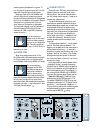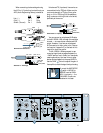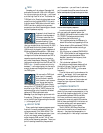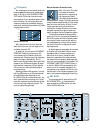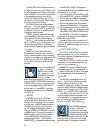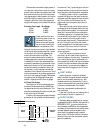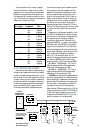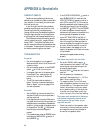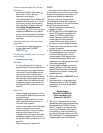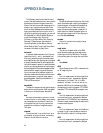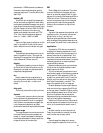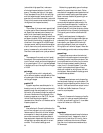
23
GENERAL PRECAUTIONS AND CONSIDERATIONS
AC POWER CONSIDERATIONS
Be sure the M•1200/M•1400 is plugged into
an outlet that is able to supply 120VAC at high
current. If the voltage should drop below
116VAC, the M•1200/M•1400 will no longer be
able to supply rated power. (It will continue to
operate down to 50% of the rated voltage, but it
just won’t be able to reach full rated power.)
Be sure the AC outlet can supply enough
current to allow full power operation of all the
amplifiers plugged into it. The outlet should be
a three-prong socket that matches the power
cord.
WARNING: Bypassing the plug’s ground pin
can be dangerous. Please don’t do it.
The AC current demand of an amplifier var-
ies depending on several factors, including the
crest factor and the duty cycle of the program
material. Under typical conditions reproducing
rock music where musical peaks are just below
clipping, the M•1200/M•1400 will require the
following average currents:
RACK MOUNTING
The M•1200/M•1400 amp requires two rack
space units (2U = 3.5"). It also requires 16.25"
depth inside the rack, including the rear sup-
ports. When designing your rack, put the
heavier items at the bottom and the lighter
items toward the top.
Secure the front panel of the amplifier to
the front of the rack using four screws with soft
washers to prevent scratching the panel. In ad-
dition, because of the weight of the amplifier,
you must secure the rear support brackets of
the amplifier to the back of the rack. You could
use a support rail or shelf across the back of
the rack, or angle brackets attached between
the rear support brackets and the rear rails of
the rack. This is recommended for all compo-
nents mounted in a rack that is going to be
moved frequently (or thrown in the back of a
pickup truck and transported down a bumpy
gravel road to that outdoor festival!).
THERMAL CONSIDERATIONS
The M•1200/M•1400 amps are fan-cooled
and bring air in through the front and out
through the sides. Make sure that cool air is
available at the front of the amplifier, and that
there is room on each side for the warm air to
exit from the amplifier and dissipate. If rack-
mounted, make sure there is room for the
warm air to circulate around the side and out
through the rear of the rack. In a typical rack,
there will be a space of 1 to 2 inches on either
side of the amplifier. This is adequate to allow
the warm air to exit from the amplifier.
The M•1200/M•1400’s unique T-Design
Constant Gradient Cooling Tunnel provides
substantially better cooling for the output tran-
sistors than conventional designs that simply
blow air through the chassis, getting dust and
other contaminants over all the internal
components. The Cooling Tunnel provides a
shorter, more directed path so the cool air con-
centrates on the heat produced by the output
devices. This results in increased reliability
and longevity for the amplifier.
Average Peak
Current Current
Amplifier Loading Required Required
2 ohms per side or 4 ohms bridged 8A 25A
4 ohms per side or 8 ohms bridged 5A 16A
8 ohms per side or 16 ohms bridged 3.2A 10A
It is recommended that a stiff supply of AC
power be used because the amplifier places
high current demands on the AC line. The
more power that is available on the line, the
louder the amplifier will play and the more
peak output power will be available for cleaner,
punchier bass.
Having said this, we also realize that in
many applications a standard 15A service may
be all that is available. Under typical condi-
tions, reproducing rock music where musical
peaks are just below the clipping point, you
can safely connect more than one amplifier to
a 15A service. Use the table below as a guide-
line:
Maximum Number
of Amplifiers
Amplifier Loading on a 15A Service
2 ohms per side or 4 ohms bridged 2
4 ohms per side or 8 ohms bridged 3
8 ohms per side or 16 ohms bridged 5



